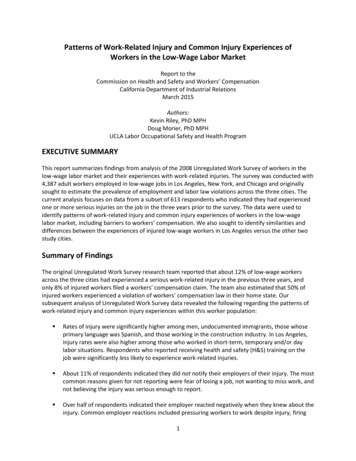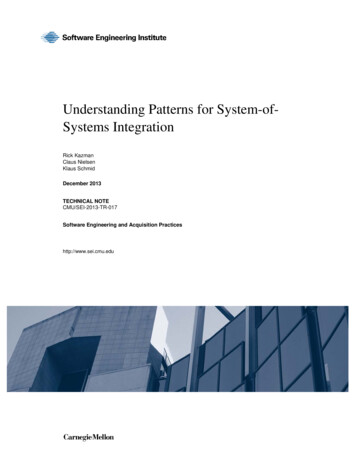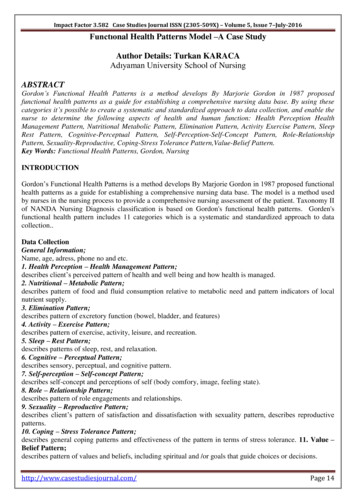
Transcription
Patterns of Work-Related Injury and Common Injury Experiences ofWorkers in the Low-Wage Labor MarketReport to theCommission on Health and Safety and Workers’ CompensationCalifornia Department of Industrial RelationsMarch 2015Authors:Kevin Riley, PhD MPHDoug Morier, PhD MPHUCLA Labor Occupational Safety and Health ProgramEXECUTIVE SUMMARYThis report summarizes findings from analysis of the 2008 Unregulated Work Survey of workers in thelow-wage labor market and their experiences with work-related injuries. The survey was conducted with4,387 adult workers employed in low-wage jobs in Los Angeles, New York, and Chicago and originallysought to estimate the prevalence of employment and labor law violations across the three cities. Thecurrent analysis focuses on data from a subset of 613 respondents who indicated they had experiencedone or more serious injuries on the job in the three years prior to the survey. The data were used toidentify patterns of work-related injury and common injury experiences of workers in the low-wagelabor market, including barriers to workers’ compensation. We also sought to identify similarities anddifferences between the experiences of injured low-wage workers in Los Angeles versus the other twostudy cities.Summary of FindingsThe original Unregulated Work Survey research team reported that about 12% of low-wage workersacross the three cities had experienced a serious work-related injury in the previous three years, andonly 8% of injured workers filed a workers’ compensation claim. The team also estimated that 50% ofinjured workers experienced a violation of workers’ compensation law in their home state. Oursubsequent analysis of Unregulated Work Survey data revealed the following regarding the patterns ofwork-related injury and common injury experiences within this worker population: Rates of injury were significantly higher among men, undocumented immigrants, those whoseprimary language was Spanish, and those working in the construction industry. In Los Angeles,injury rates were also higher among those who worked in short-term, temporary and/or daylabor situations. Respondents who reported receiving health and safety (H&S) training on thejob were significantly less likely to experience work-related injuries. About 11% of respondents indicated they did not notify their employers of their injury. The mostcommon reasons given for not reporting were fear of losing a job, not wanting to miss work, andnot believing the injury was serious enough to report. Over half of respondents indicated their employer reacted negatively when they knew about theinjury. Common employer reactions included pressuring workers to work despite injury, firing1
them shortly after injury, and/or threatening them with deportation or firing. A small proportionof respondents (11%) reported that employers provided them with a workers’ compensationclaim form and/or told them to file. Undocumented residents were significantly more likely to experience negative reactions fromemployers following injury and were significantly less likely to seek medical attention. They werealso significantly less likely to receive workers’ compensation claim forms from employers or filefor workers’ compensation. Workers who reported they received H&S training on the job were more likely to seek medicalattention, more likely to notify their employers, less likely to report negative reactions, morelikely to receive workers’ compensation claim forms from employers, and more likely to file forworkers’ compensation.Finally, respondents in Los Angeles were somewhat more likely than those in New York or Chicago toindicate they had avoided notifying employers of their injury because they were afraid of losing theirjobs or did not want to miss work. Los Angeles was also the only city where respondents indicated theyhad not notified employers because they were unaware they could receive benefits. And Los Angelesrespondents had the lowest proportion of accepted workers’ compensation claims. Employer reactionstoward injured workers were roughly comparable across the three cities, suggesting that differences inrates of legal violations reported by the original study team are driven more by variations in stateworkers’ compensation laws than by different patterns of employer behaviors.ImplicationsThe findings from this study provide a valuable window into the injury experiences of workers in thelow-wage labor market in the three largest U.S. cities. The analysis shines light on the overlappingvulnerabilities faced by low-wage workers who experience work-related injuries. The combination ofeconomic insecurity and adverse interactions with employers contributes to low rates of reporting anddenial of workers’ compensation. These factors are particularly acute for undocumented residents, forwhom the workers’ compensation system remains especially inadequate.Health and safety training appears to serve as a protective mechanism within this sample, encouragingmore workers to come forward with their injuries and fewer employers to react with threats orintimidation. The specific mechanisms through which training produces these outcomes are unclear;more research is needed. But the findings underscore the need for additional education of low-wageworkers regarding workplace hazards and their rights on the job, including the right to compensation forwork-related injuries and protections from retaliatory employer behavior.2
BACKGROUNDIn 2008, researchers conducted a landmark survey of workers in the low-wage labor market in LosAngeles, New York, and Chicago to estimate the prevalence of employment and labor law violations. TheUnregulated Work Survey was conducted in the three largest U.S. cities with 4,387 adult workers whohad been employed in low-wage jobs within the previous year. The study examined workers’experiences with employers who failed to pay minimum wage, denied overtime pay, forced them towork off the clock, or denied meal or rest breaks. In their final published reports of the study, theresearch team estimated that more than two-thirds (68%) of low-wage workers across the three citieshad experienced at least one pay-related violation during the prior workweek (Bernhardt, Milkman,Theodore et al. 2009).In addition to wage and hour violations, the research team sought to estimate the number of workerswho had experienced violations of workers’ compensation law. In order to generate this estimate, thesurvey gathered information from a subset of respondents who indicated they had experienced at leastone serious injury on the job in the previous three years. Questions included whether respondentsreported their injuries to employers and why or why not, how employers responded to knowledge ofworker injuries, whether respondents sought medical treatment, and whether they were compensatedfor missed work and/or medical care. The original research team reported that about 12% of workershad experienced a serious work-related injury in the previous three years, and only 8% of thoseworkers had filed a workers’ compensation claim (Table 1). They estimated that when employers knewabout the injury, 50% of injured workers experienced some sort of illegal employer reaction thatconstituted a violation of workers’ compensation law, including firing the worker, calling immigrationauthorities, or instructing the worker not to file for workers’ compensation (Bernhardt, Milkman,Theodore et al. 2009).Table 1: Injury Statistics from Unregulated Work Survey, 2008LANYCCHITotalPercent of sample that experienced workrelated injuryPercent of injured workers who filed WCclaimPercent of injured workers whoexperienced WC violation11.31115124.3119889.8162050Among workers seeking medical care,percent for whom WC insurance paid bills7.5636Source: Bernhardt, A., Milkman, R., Theodore, N., Heckathorn, D., Auer, M., DeFilippis, J., &Spiller, M. (2009). Broken Laws, Unprotected Workers. National Employment Law Project. NewYork: NELP. http://www.unprotectedworkers.org/index.php/broken laws/indexThe information in the Unregulated Work Survey gathered from workers who had experienced injurieson the job served as the starting point for the present analysis. Beyond specific violations of stateworkers’ compensation laws, we were interested in what additional insights these data could provide interms of patterns of work-related injury and the common experiences of injured workers in the lowwage labor market. What do respondents’ experiences reveal about the nature of vulnerability for lowwage workers who are injured? How do these experiences contributed to underreporting and/or denialof workers’ compensation for this worker population?3
Existing research on the injury experiences of low-wage workers and their attempts to access workers’compensation has faced a number of challenges. Recruiting respondents is often difficult due to the“invisibility” of low-wage work and the widespread fear and precariousness many workers endure. Thestudies that exist have largely relied on small samples drawn from specific industries or worker groups(e.g., Levin & Ginsburg 1999; Brown et al. 2002; Walter, Bourgois, Margarita Loinaz & Schillinger 2002;Theodore, Valenzuela & Melendez 2006; Quandt, Grzywacz, Marin, et al. 2006; Seixas, Blecker, Camp &Neitzel 2008; Zoeckler, Lax, Gonos et al. 2014). Such studies offer useful insights, but they generallyprovide few opportunities to quantify the true scope of reporting problems or document commonalitiesacross industries, geographic area, or diverse worker populations. In addition, while a number of studieshave considered workers’ perceived fears in reporting injuries (e.g., Azaroff, Levenstein & Wegman2002), few have had the chance to document the actual experiences of injured workers, theirinteractions with employers following injury, and their difficulties accessing appropriate care andworkers’ compensation (but see Walter et al. 2002; Pransky et al. 2002; Zoeckler, Lax, Gonos et al.2014).The 2008 Unregulated Work Survey provides a promising avenue for examining the experiences ofinjured low-wage workers in a broader and more systematic way. The innovative sampling of workersacross three large cities and representing a variety of industries and job types can offer moregeneralizable lessons about the dynamics of injury underreporting and the failure of state workers’compensation systems to reach many workers in the low-wage labor market. And the sizable portion ofthe sample from Los Angeles can shed insights on similarities and differences in the injury experiences oflow-wage workers here as compared to other large metropolitan areas (Milkman, Gonzalez & Narro2010).METHODOLOGYThis project focused exclusively on analysis of existing data from the 2008 Unregulated Work Survey.The data were made publicly available in January 2013, allowing for further analysis by researchersbeyond the original study team.The Unregulated Work Survey was conducted with 4,387 adult workers in Los Angeles (Los AngelesCounty), New York City (the five boroughs), and Chicago (Cook County) who had been employed asfrontline workers (i.e., not managers, professionals, or technical workers) in low-wage industries withinthe previous year. Low-wage industries were defined as those whose median wage for frontline workerswas less than 85% of the city’s median wage. Median hourly wages for each city were identified usingthe Center for Economic Policy Research’s 2006 Current Population Survey; industries in each city thatfell below the medians were identified using 2000 U.S. Census data.11The study team had this to say regarding the timing of their data collection: “We fielded the survey at the start ofthe recession in 2008, but in all three cities, the recession had not yet fully set in when we were conducting ourinterviews. Unemployment rates—the most relevant measure in terms of labor market conditions—were juststarting to edge upward in each of the three cities, and did not reach critical levels until late 2008 and early 2009,after we had completed our survey. Our assessment, therefore, is that the workplace violation rates documentedin this study were not significantly influenced by the recession.” (Bernhardt, Milkman, Theodore, et al. 2009, p.12).4
Survey respondents were recruited using an innovative sampling strategy known as “respondent-drivensampling” (RDS), a form of chain-referral sampling that (a) can reach respondents from “hidden”populations that are often missed in standard survey approaches and (b) incorporates properties ofprobability sampling methods that allow one to make inferences about the population based on sampledata (Heckathorn 1997; Heckathorn 2007; Salganik & Heckathorn 2008). RDS uses mathematicalmodeling to weight data based on respondents’ social network size—i.e., based on their probability ofbeing captured by the survey technique—as well as other features of the network that can affect thesampling process. The use of this approach in the Unregulated Work Survey allowed the original studyteam to generate statistically representative prevalence estimates of various workplace violations(Bernhardt, Milkman, Theodore, et al. 2009).2The large but concentrated low-wage labor markets in Los Angeles, New York, and Chicago provided theoriginal study team the opportunity to survey a diverse population of low-wage workers in definedgeographical areas and to capture a wide range of sectors, industries and occupations. Our analysis tookadvantage of the study scope and unique sampling characteristics to address the following threeresearch questions:1. How do rates of work-related injury vary by worker and job characteristics?2. What are the most commonly reported experiences of workers in the low-wage labor marketwho are injured on the job? How do those experiences vary by worker and job characteristicsand across cities?3. What factors support or undermine injury reporting and access to workers’ compensationamong workers in the low-wage labor market?The characteristics of the overall Unregulated Work Survey sample and population prevalence estimatesbased on this sample are described elsewhere (Bernhardt, Milkman, Theodore, et al. 2009; Bernhardt,Spiller & Polson 2013). Briefly, approximately 63% of the sample was Latino, 45% had less than highschool education, and 39% were undocumented residents. The most common industries whererespondents worked included restaurants and hotels (17%), private households (14%), apparel andtextile manufacturing (13%), and retail and drug stores (10%). The median wage of respondents was 8.02 per hour (in 2008 dollars).For our analysis, the 4,387 respondents from the original survey were stratified according to whetherthey experienced a work-related injury in the three years prior to participation in the study. (A seriousinjury was defined as one requiring medical attention, regardless of whether the person actually soughtmedical attention.) A subset of 613 respondents indicated they had experienced one or more seriousinjuries on the job in the previous three years. These respondents were subsequently asked a series ofadditional questions, including whether they reported their injury to their employer and why or whynot, how employers responded to the injury, whether they missed work and/or sought medicaltreatment as a result of the injury, and whether they received workers’ compensation. These dataserved as the basis for our analysis.We conducted all data analyses using R statistical software, Version 3.0.2. Weighted prevalenceestimates of socio-demographic characteristics for the injured and uninjured strata and theircorresponding 95% confidence intervals were generated using the Respondent-Driven Sampling Analysis2For additional details on the sampling and estimation techniques used in the original Unregulated Work Survey,see Spiller, Bernhardt, Perelshteyn & Heckathorn 2010.5
Tool (RDSAT), Version 7.1.38. The default RDS-I weights with enhanced smoothing were used along with15,000 bootstrap samples.A couple of important notes on the limitations of this dataset for examining questions regarding theinjury experiences of workers in the low-wage labor market: The original research team did not ask anyquestions about the specific nature of the reported injuries, so we have few clues as to the kinds ofworkplace hazards respondents encountered that caused harm. Respondents in this study may havebeen hesitant to disclose work-related injuries or negative injury experiences to interviewers due tofears of employer retaliation or other concerns. Injuries may also be undercounted in this sample ifrespondents did not recognize injuries to be work related. Furthermore, reliance on self-reportedinformation may reflect a degree of recall bias. For example, our analysis indicates that those whoprovided information about injuries longer ago tended to describe more severe injuries (i.e., they weremore likely to miss work and/or seek medical attention). And self-reported information regardingemployer behaviors and payment for missed days and/or medical care may also be shaped by one’sfeelings about an employer, whether negative or positive. We have done our best to keep theseconsiderations in mind in analyzing these survey results.FINDINGSThe original study reports for the Unregulated Work Survey included limited findings regarding theinjury experiences of respondents (see Table 1). Our analysis delved further into the characteristics ofthese injured workers and their experiences following injury.Patterns of Injury and Characteristics of Injured WorkersTable 2 shows the proportion of respondents who experienced at least one work-related injury in theprevious three years as well as the number of injuries they experienced and the proportion that missedwork and/or sought medical attention. Nearly one third of respondents (32%) indicated they hadexperienced more than one injury in the previous three years. Time since respondents’ most recentinjury ranged from zero to 41 months with a median of 12 months; three participants reported theirmost recent injury was more than three years ago (data not shown). While the study did not gatherTable 2: Number of Injuries and Severity of Most Recent InjuryTOTAL%LOS ANGELES%Number of times injured in last 3 years123 4(n 612)68.5%18.5%6.5%6.7%(n 276)67.8%20.3%6.2%5.8%For most recent injury:Missed work onlySought medical attention onlyMissed work and sought med attnNeither of these(n 612)13.6%14.1%47.9%24.5%(n 276)16.7%14.9%42.0%26.4%6
information about the nature of injuries, questions were asked about whether respondents missed oneor more days of work and/or received medical care as a result of the injury. About half of respondents(48%) both missed work and sought medical attention, combined factors that may serve as a crudemeasure of injury severity.Table 3 compares the demographic and job characteristics of respondents who experienced a seriouswork-related injury in the previous three years versus those who did not. Low-wage workers whoexperienced injuries were more likely to be male, Spanish as first language, and undocumentedresidents. In addition, workers in construction were more likely to experience work-related injuries thanthose in other industries. Latino workers and those working as short term, temporary or day laborersalso appeared more likely to experience injuries, although differences in prevalence point estimateswere not statistically significant at the 95% confidence level. U.S.-born citizens and workers whose firstlanguage is English were less likely to experience work-related injuries. In addition, respondents whoindicated having received health and safety information when they started their job were less likely toexperience injuries than those who had not received this information.3 Other demographic and jobcharacteristics such as age, education, job tenure, employer size, and union membership were notcorrelated with injury rates.Table 4 provides the same comparison of respondents who did and did not experience a serious workrelated injury in the previous three years specifically for the subset of Los Angeles respondents. Similarpatterns are evident. Those who experienced work-related injuries were more likely to be male, Spanishas first language, and undocumented residents. Construction workers and those working as short term,temporary or day laborers were also more likely to experience serious injuries. Receiving health andsafety training was not significantly associated with lower injury rates as it was in the overall sample.3The survey specifically asked whether respondents received health and safety training in their current job; thismay not have been the job in which they experienced injury. See the Discussion section below for furtherconsideration of the interpretation of these results.7
Table 3: Characteristics of Survey Subsamples: Respondents who Indicated SeriousWork-Related Injuries in the Previous Three Years versus Those who Did Not, by SelectDemographic and Job CharacteristicsSubsample WhoExperienced Injury1(n 613)Point Est. (95% CI)GenderMale0.548 (0.478, 0.617)Female0.452 (0.383, 0.522)Race/EthnicityLatino/a or Hispanic0.785 (0.723, 0.846)Black or African American0.085 (0.050, 0.120)Asian or other race0.103 (0.052, 0.154)White0.027 (0.007, 0.046)Age18-25 years0.241 (0.183, 0.298)26-35 years0.291 (0.227, 0.355)36-45 years0.251 (0.187, 0.315)46 years0.217 (0.162, 0.273)EducationLess than high schooldegree, no GED0.510 (0.442, 0.577)High school degree or GED0.268 (0.213, 0.323)Some college or associate'sdegree0.160 (0.115, 0.204)College or higher degree0.064 (0.042, 0.086)R's first languageEnglish0.190 (0.139, 0.241)Spanish0.716 (0.648, 0.784)Chinese-Other0.076 (0.026, 0.125)Nativity and immigration statusUS-born citizen0.192 (0.141, 0.242)Foreign-born citizen0.103 (0.066, 0.140)Documented resident0.151 (0.103, 0.200)Undocumented resident0.554 (0.479, 0.629)Industry/occupation during previous workweekBldg services: janitors,grounds maintenance andother occs0.047 (0.024, 0.070)Bldg services: securityguards0.016 (0.003, 0.029)Construction industry: allgeneral occs0.129 (0.082, 0.176)Education, social services,hospitals, and health care0.060 (0.032, 0.088)Grocery stores: cashiers,stock clerks, other occs0.070 (0.040, 0.100)Home health: homecareworkers--8Subsample Who Did NotExperience Injury(n 3,774)Point Est. (95% CI)PointEst.Ratio0.425 (0.390, 0.460)0.575 (0.540, 0.609)1.290.790.680 (0.623, 0.738)0.145 (0.110, 0.180)0.136 (0.099, 0.173)0.039 (0.017, 0.061)1.150.590.760.690.232 (0.202, 0.262)0.257 (0.227, 0.288)0.243 (0.212, 0.274)0.268 (0.236, 0.301)1.041.131.030.810.537 (0.505, 0.569)0.274 (0.247, 0.301)0.950.980.119 (0.104, 0.133)0.070 (0.052, 0.088)1.340.910.307 (0.260, 0.354)0.579 (0.514, 0.644)0.049 (0.007, 0.091)0.065 (0.034, 0.097)0.621.24-1.170.294 (0.250, 0.339)0.126 (0.103, 0.149)0.184 (0.157, 0.211)0.395 (0.351, 0.440)0.650.820.821.400.049 (0.037, 0.061)0.960.024 (0.015, 0.033)0.670.048 (0.034, 0.061)2.690.061 (0.049, 0.074)0.980.057 (0.041, 0.073)1.230.047 (0.035, 0.059)--
Table 3 (cont.)Industry/occupation during previous workweek (cont.)Manufacturing: apparel andfood/furniture0.175 (0.115, 0.234)Personal & repair services:car wash workers, laundry,hair dressers0.041 (0.021, 0.061)Private HH: housekeeperand other occ0.078 (0.034, 0.121)Private HH: childcare andhome health care occs0.053 (0.014, 0.093)Restaurants & hotels:dishwashers, janitors,housekeepers0.057 (0.025, 0.090)Restaurants & hotels:cashiers, other frontline0.032 (0.010, 0.055)Restaurants & hotels:waiters and waitresses0.021 (0.004, 0.038)Restaurants & hotels: cooks,food prep/combinedworkers0.079 (0.050, 0.107)Retail & drug stores:cashiers, stock clerks andother front-line occs0.042 (0.015, 0.069)Retail and drug stores: salespersons0.043 (0.021, 0.066)Transportation industries(warehousing, couriers,parking lots): all occs0.034 (0.018, 0.049)Union membershipNot a union member0.931 (0.898, 0.963)Union member0.069 (0.037, 0.102)Job tenure2 yr or less0.693 (0.638, 0.748)3-4 yrs0.125 (0.087, 0.162)5 yrs0.182 (0.137, 0.227)Employer sizeUnder 100 employees0.699 (0.643, 0.755)100 employees or more0.301 (0.245, 0.358)Short term, temp, day laborNo0.698 (0.630, 0.766)Yes0.302 (0.234, 0.370)R received health/safety info when starting jobYes0.383 (0.315, 0.450)No0.617 (0.550, 0.684)1 Serious0.186 (0.157, 0.215)0.940.052 (0.040, 0.065)0.790.094 (0.069, 0.119)0.830.072 (0.055, 0.089)0.740.029 (0.020, 0.038)1.970.039 (0.029, 0.049)0.820.034 (0.021, 0.046)0.620.062 (0.042, 0.082)1.270.047 (0.036, 0.058)0.890.055 (0.037, 0.073)0.780.044 (0.028, 0.060)0.770.943 (0.930, 0.957)0.057 (0.043, 0.070)0.991.210.719 (0.692, 0.746)0.142 (0.124, 0.160)0.139 (0.116, 0.162)0.960.881.310.699 (0.667, 0.730)0.301 (0.270, 0.333)1.001.000.772 (0.740, 0.804)0.228 (0.197, 0.260)0.901.320.509 (0.474, 0.543)0.491 (0.457, 0.526)0.751.26work-related injury is defined as injury requiring medical attention, whether or not the respondentsought out medical care.Boldface font indicates no overlap of 95% CI for prevalence estimates between the injured and uninjured.9
Table 4: Characteristics of Survey Subsamples: Respondents who Indicated SeriousWork-Related Injuries in the Previous Three Years versus Those who Did Not, by SelectDemographic and Job Characteristics (LA Subsample)Subsample WhoExperienced Injury1(n 276)Point Est. (95% CI)GenderMale0.616 (0.490, 0.708)Female0.384 (0.292, 0.510)Race/EthnicityLatino/a or Hispanic0.921 (0.862, 0.974)Black or African American0.030 (0.005 ,0.045)Asian or other race0.047 (0.009, 0.110)White0.002 (0.000, 0.007)Age18-25 years0.200 (0.132, 0.308)26-35 years0.270 (0.167, 0.369)36-45 years0.323 (0.233, 0.460)46 years0.207 (0.107, 0.287)EducationLess than high schooldegree, no GED0.633 (0.534, 0.730)High school degree or GED0.204 (0.143, 0.304)Some college or associate'sdegree0.120 (0.069, 0.185)College or higher degree0.044 (0.006, 0.047)R's first languageEnglish0.111 (0.054, 0.172)Spanish0.858 (0.784, 0.933)Chinese0.019 (0.000, 0.083)Other0.011 (0.000, 0.022)Nativity and immigration statusUS-born citizen0.115 (0.054, 0.175)Foreign-born citizen0.045 (0.014, 0.068)Documented resident0.140 (0.080, 0.239)Undocumented resident0.701 (0.597, 0.801)Industry/occupation during previous workweekBldg services: janitors,grounds maintenance andother occs0.050 (0.022, 0.104)Bldg services: securityguards0.016 (0.000, 0.037)Construction industry: allgeneral occs0.212 (0.131, 0.324)Education, social services,hospitals, and health care0.074 (0.034, 0.131)Grocery stores: cashiers,stock clerks, other occs0.004 (0.000, 0.010)Home health: homecareworkers0.001 (0.000, 0.000)10Subsample Who Did NotExperience Injury(n 1,815)Point Est. (95% CI)PointEst.Ratio0.452 (0.395, 0.505)0.548 (0.494, 0.604)1.360.700.822 (0.741, 0.901)0.056 (0.029, 0.088)0.110 (0.050, 0.177)0.012 (0.003, 0.029)1.120.540.430.170.190 (0.146, 0.231)0.280 (0.235, 0.340)0.254 (0.204, 0.309)0.277 (0.218, 0.330)1.050.961.270.750.696 (0.643, 0.742)0.203 (0.166, 0.248)0.911.000.068 (0.051, 0.086)0.033 (0.013, 0.060)1.761.330.174 (0.117, 0.243)0.727 (0.603, 0.822)0.069 (0.005, 0.177)0.030 (0.004, 0.072)0.641.180.280.370.162 (0.108, 0.227)0.105 (0.072, 0.148)0.158 (0.121, 0.197)0.575 (0.495, 0.642)0.710.430.891.220.054 (0.038, 0.074)0.930.019 (0.007, 0.032)0.840.065 (0.043, 0.087)3.260.036 (0.024, 0.048)2.060.019 (0.010, 0.029)0.210.030 (0.017, 0.045)0.03
Table 4 (cont.)Industry/occupation during previous workweek (cont.)Manufacturing: apparel andfood/furniture0.218 (0.141, 0.339)Personal & repair services:car wash workers, laundry,hair dressers0.019 (0.006, 0.037)Private HH: housekeeperand other occ0.146 (0.058, 0.240)Private HH: childcare andhome health care occs0.041 (0.015, 0.082)Restaurants & hotels:dishwashers, janitors,housekeepers0.024 (0.003, 0.047)Restaurants & hotels:cashiers, other frontline0.024 (0.000, 0.081)Restaurants & hotels:waiters and waitresses0.012 (0.002, 0.028)Restaurants & hotels: cooks,food prep/combinedworkers0.051 (0.024, 0.087)Retail & drug stores:cashiers, stock clerks andother front-line occs0.037 (0.005, 0.051)Retail and drug stores: salespersons0.020 (0.002, 0.047)Transportation industries(warehousing, couriers,parking lots): all occs0.051 (0.016, 0.073)Union membershipNot a union member0.973 (0.938, 0.996)Union member0.027 (0.004, 0.062)Job tenure2 yr or less0.743 (0.677, 0.829)3-4 yrs0.108 (0.065, 0.157)5 yrs0.149 (0.082, 0.201)Employer sizeUnder 100 employees0.791 (0.712, 0.880)100 employees or more0.209 (0.120, 0.292)Short term, temp, day laborNo0.589 (0.467, 0.710)Yes0.411 (0.291, 0.532)R received health/safety info when starting jobYes0.359 (0.257, 0.470)No0.641 (0.529, 0.743)1 Serious0.287 (0.231, 0.342)0.760.019 (0.010, 0.035)1.000.144 (0.097, 0.195)1.010.047 (0.031, 0.067)0.870.019 (0.011, 0.030)1.260.014 (0.008, 0.022)1.710.025 (0.014, 0.040)0.480.059 (0.033, 0.098)0.860.021 (0.011, 0.033)1.760.055 (0.025, 0.094)0.360.085 (0.056, 0.126)0.600.970 (0.955, 0.982)0.030 (0.019, 0.045)1.000.900.772 (0.730, 0.812)0.119 (0.095, 0.144)0.109 (0.077, 0.145)0.960.911.370.816 (0.754, 0.843)0.184 (0.156, 0.245)0.971.140.735 (0.689, 0.795)0.265 (0.205, 0.309)0.801.550.434 (0.382, 0.493)0.566 (0.507, 0.620)0.831.13work-related injury is defined as injury requiring medical attention, whether or not the respondentsought out medical care.Boldface font indicates no overlap of 95% CI for prevalence estimates between the injured and uninjured.11
Injury Experiences of Workers in Low-Wage IndustriesFor respondents who experienced serious work-related injuries, additional information regarding theirmost recent injury was gathered, including whether they informed their employers, how the employerresponded, how they paid for missed work or medical care, and whether they received workers’compensation.Reporting Injuries to EmployersA majori
Kevin Riley, PhD MPH Doug Morier, PhD MPH UCLA Labor Occupational Safety and Health Program EXECUTIVE SUMMARY This report summarizes findings from analysis of the 2008 Unregulated Work Survey of workers in the low-wage labor market and their experiences











